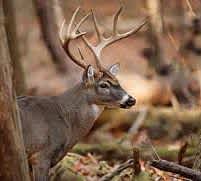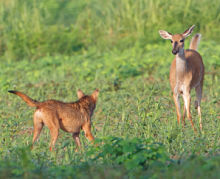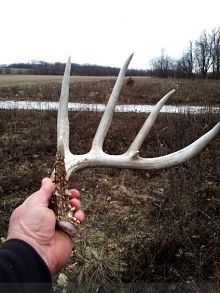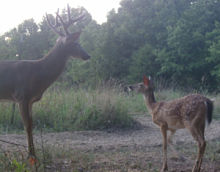Ten Off-season Hunting Tips for a Better Next Year
In Search of Whitetails 02.12.13

Well, it’s the off-season. Deer and turkey hunting seasons are closed, and opening day for either seems a long way off. It’s the hunter’s lull, the long stretch of non-hunting that we dread every year. This time, I won’t let my fall-hunting self down. I’ve found 10 ways to keep my skills sharp and improve the odds for next year’s deer and turkey seasons.
1. Do Some Post-season Scouting
Remember the elusive buck whose bedding area you couldn’t pinpoint during the bow season? Now’s the time to track him down in the open woods. A fresh snowfall offers the perfect opportunity to scout and map out the deer movement in places you’d like to hunt next year. As I discussed in my article on deer hunting in snow, some of the things you’ll find will surprise you.
2. Visit the Shooting Range
As I wrote in my article on shooting range design and operation, I recently went out to sight in my grandfather’s 30-06 and pattern his Remington 1100 shotgun. This is a perfect time to zero in a new scope or practice shooting from distance. Skeet or trap shooting will keep your shotgunning skills sharp and hey, they’re a lot of fun. Finally, the range is one place that you can go and find a lot of other hunters in the off-season. I sure hope to make some new friends and acquaintances that way.
3. Try Predator Hunting
Here’s a recent fact I’ve learned that should ignite your passion for hunting predators. A long-term study of coyote predation found that as many as 75% of newborn deer fawns are killed by coyotes in their first three days of life. Hunting predators is intense and challenging — you imitate wounded prey animals to draw them in; the response can be fast and furious. You start making a wounded rabbit call, and anything could show up: coyote, fox, even a bobcat. Successfully hunting predators not only reduces their impact on deer and turkey young, but challenges you to improve at least three skills to make you a better deer and turkey hunter.
- Hunting the wind. Coyotes have a sense of smell that might even surpass the whitetail’s. They’ll actively circle around downwind of you while calling to get a sniff. You have to take the wind into account on every hunt.
- Stealth and concealment. Predators have superior sight and hearing. Hunting them will teach you to remain absolutely still and silent.
- Accurate shooting. What better excuse to practice your rifle or shotgun skill than on small, elusive targets? It’s better practice than the range, because you’re shooting at live targets and usually from a distance.
See the Coyote Hunting Tips at Field & Stream to get started.
4. Hunt for Sheds
Here’s a pastime of many hunters that gets you out into the woods and helps you locate trophy deer for next season. Hunting shed antlers (sheds) is all about timing, because you want to devote time after the bucks have shed their antlers, but before the rodents and vermin get to them. Shed time varies according to climate and altitude; here in Missouri shed hunters were already making finds in January and continue to do so in February.
You can also use a digital scouting camera to monitor bucks and learn (with some precision) when they’ve lost their antlers. There’s a nice article on shed hunting over at Buck Managers.
5. Learn New Hunting Skills
The off-season is a perfect time to pick up (or practice) new skills that could help you next season. It might be tracking, scouting, marksmanship, or some other aspect of deer hunting. Personally, I’m learning to shoot my grandfather’s 30-06 and Remington 1100 shotgun in preparation for next year’s firearms deer hunting season.
Check out our article on essential skills for bowhunting if you need some more ideas.
6. Manage Land to Support Game
Spring and summer offer numerous opportunities to improve your own land so that it better supports the populations of deer, turkey, and other game. Here are some quick ideas for how you might do that:
- Hinge-cut low-value tree species (box elder, sweet gum) to create more bedding cover
- Make clear cuts in winter or early spring
- Put out salt or mineral licks
- Build a small pond with enough cover to provide a good water source.
- Plant crops or native food species
There’s undoubtedly a lot more that you can do to support the wildlife on your land; your local conservation office would probably love to offer you some suggestions.
7. Find Private Land to Hunt
So here’s one area I’d really like to focus on this spring and summer: finding and obtaining permission to hunt on private land. In Missouri (and many states), the majority of hunting takes place on privately owned land. Sure, there’s public land to hunt, and I’m grateful for that, but I’d just as soon find some nearby spots where the pressure’s not as high. I have to admit that this is an aspect of hunting I’ve not really tried my hand at.
Petersen’s Hunting has an article with 8 tips for getting permission to hunt on private land that I intend to try out.
8. Score Some Hunting Gear
After the close of deer season, many retails are trying to clearance out their hunting gear. Just like January for cars or the end of summer for boats, now is the time to shop for deer hunting equipment. Wal-Mart is a good place to look now; they dramatically mark down much of their hunting gear (deer hunting equipment and camo clothes, especially) around this time of year.
Now’s a good time to look around on eBay for hunting gear, too. A lot of hunters are now realizing that they don’t have the space to store all of their new gear. If you’ve had your eye on something rather expensive all season long, you might also be able to get it at a good price. Just look at all the compound bows on eBay.
9. Use Trail Cameras
Deer, turkey, and other big game aren’t just around during hunting season. They have lives and patterns throughout the year. In the late winter, spring, and summer, there’s relatively little human pressure on them, and thus a greater opportunity to learn their movements.
Setting up some trail cameras on the lands that you hunt gives you a long-term view of their activities without losing any hunting time. You might also pick up some good entries for next year’s trail cam photo contest at Field & Stream.
10. Protect Hunting’s Future
These are uncertain times for gun owners and hunters in the United States. Recent tragedies have made tighter gun control a priority for many hunters. With the economy hurting, governments are also cutting federal, state, and local programs; recreation and conservation are often the hardest hit by such cuts.
Finally, we must be wary of those groups ignorant or nutty enough to think that hunting is a bad thing. As long as we’re all out of the woods, let’s do what we can to protect our rights to bear arms and harvest game. Let’s write or call to make our feelings (support or criticism) known to lawmakers. That’s what it will take to ensure the future of hunting in America.




